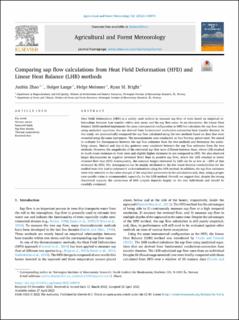| dc.contributor.author | Zhao, Junbin | |
| dc.contributor.author | Lange, Holger | |
| dc.contributor.author | Meissner, Helge Rainer | |
| dc.contributor.author | Bright, Ryan M. | |
| dc.date.accessioned | 2022-08-02T18:04:41Z | |
| dc.date.available | 2022-08-02T18:04:41Z | |
| dc.date.created | 2022-04-28T09:53:14Z | |
| dc.date.issued | 2022-06-15 | |
| dc.identifier.citation | Agricultural and Forest Meteorology. 2022, 321 1-10. | en_US |
| dc.identifier.issn | 0168-1923 | |
| dc.identifier.uri | https://hdl.handle.net/11250/3009857 | |
| dc.description.abstract | Heat Field Deformation (HFD) is a widely used method to measure sap flow of trees based on empirical relationships between heat transfer within tree stems and the sap flow rates. As an alternative, the Linear Heat Balance (LHB) method implements the same instrumental configuration as HFD but calculates the sap flow rates using analytical equations that are derived from fundamental conduction-convection heat transfer theories. In this study, we systematically compared the sap flow calculated using the two methods based on data that were recorded using the same instrument. The measurements were conducted on four Norway spruce trees. We aimed to evaluate the discrepancies between the sap flow estimates from the two methods and determine the underlying causes. Diurnal and day-to-day patterns were consistent between the sap flow estimates from the two methods. However, the magnitudes of the estimated sap flow were different between them, where LHB resulted in much lower estimates in three trees and slightly higher estimates in one compared to HFD. We also observed larger discrepancies in negative (reversed flow) than in positive sap flow, where the LHB resulted in lower reversed flow than HFD. Consequently, the seasonal budget estimated by LHB can be as low as ∼20% of that estimated by HFD. The discrepancies can be mainly attributed to the low wood thermal conductivities for the studied trees that lead to substantial underestimations using the LHB method. In addition, the sap flow estimates were very sensitive to the value changes of the empirical parameters in the calculations and, thus, using a proper case-specific value is recommended, especially for the LHB method. Overall, we suggest that, despite the strong theoretical support, the correctness of LHB outputs depends largely on the tree individuals and should be carefully evaluated. | en_US |
| dc.language.iso | eng | en_US |
| dc.publisher | Elsevier B.V. | en_US |
| dc.rights | Navngivelse 4.0 Internasjonal | * |
| dc.rights.uri | http://creativecommons.org/licenses/by/4.0/deed.no | * |
| dc.title | Comparing sap flow calculations from Heat Field Deformation (HFD) and Linear Heat Balance (LHB) methods | en_US |
| dc.title.alternative | Comparing sap flow calculations from Heat Field Deformation (HFD) and Linear Heat Balance (LHB) methods | en_US |
| dc.type | Peer reviewed | en_US |
| dc.type | Journal article | en_US |
| dc.description.version | publishedVersion | en_US |
| dc.rights.holder | © 2022 The Author(s) | en_US |
| dc.source.pagenumber | 10 | en_US |
| dc.source.volume | 321 | en_US |
| dc.source.journal | Agricultural and Forest Meteorology | en_US |
| dc.identifier.doi | 10.1016/j.agrformet.2022.108974 | |
| dc.identifier.cristin | 2019715 | |
| dc.relation.project | Norges forskningsråd: 294948 | en_US |
| dc.source.articlenumber | 108974 | en_US |
| cristin.ispublished | true | |
| cristin.fulltext | original | |
| cristin.qualitycode | 1 | |

